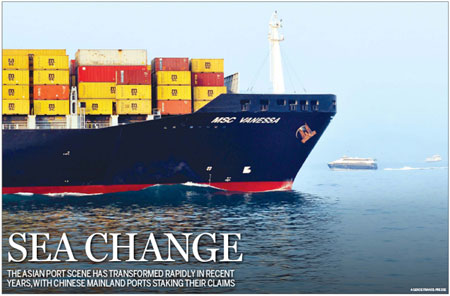Center
Sea Change
Updated: 2011-01-14 11:32
By WONG JOON SAN (China Daily European Weekly)
|
 Industry officials estimate that Hong Kong handled about 23.6 million standard containers last year, up almost 30 percent year-on-year.Chen Fei / Xinhua |
There has been quiet but remarkable realignment and repositioning in the order in the sea. Of the 10 busiest ports in the world, nine are in Asia; of the top 10, five are in the Chinese mainland; Singapore is struggling hard to regain its No 1 position; and Hong Kong, which was for so long engaged in a two-horse race with the island republic, has been relegated to third position; and the emerging powerhouse Shenzhen comes in at fourth.
There is nothing surprising about this changed script. It is all because of the fabled China factor that is quite in consonance with its long and steady march to the acme of growth and success.
In short, the gentle colossus that is China has stirred up quite a revolution in the waters.
"The explosion in international trade has had a tremendous impact on the port sector, something that has forced China's planners to expand its port capacity. It's a matter of national interest. The country's strong trade performance has continued to power ahead year by year," says Leslie Loh, a Shenzhen-based analyst at FAM, which focuses on supply-chain data analysis.
Riding the tide of global trade expansion, Shanghai has dethroned Singapore for the first time to earn the title of the world's busiest container port. According to the Shanghai International Port Group (SIPG), Hong Kong and Shenzhen are in a neck-and-neck race for the third and fourth place.
Shanghai port, which handled 29.1 million of 20-foot-equivalent units (TEUs) of standard sized container boxes in 2010, was up 16.3 percent year-on-year while its cargo tonnage grew 17.3 percent to 428.35 million tons. Singapore's container throughput for 2010 was slightly lower with 28.4 million TEUs, an increase of about 10 percent over 2009.
International container shipping that started in 1966, when a container ship sailed from Port Elizabeth in the US to Rotterdam in the Netherlands, has come a long way.
In the 1970s, only American and European ports dominated the scene and the port volume rankings would be shared by Oakland, Rotterdam, Seattle, Antwerp and Belfast. Singapore and Hong Kong were way down the ladder, and ports in the Chinese mainland barely registered their presence.
But as international goods and services grew stronger and global trade expanded exponentially, Singapore and Hong Kong steadily steamed their way to the top.
Enormously to its credit, Singapore held the status of being the busiest port in the world from 1986.
Shanghai's transformation into the world's busiest container port is the result of China's economic boom and explosive growth of exports in the Yangtze River Delta. While Hong Kong used to be the entrepot - the only gateway to the Chinese mainland in the past - Shanghai, Ningbo and Shenzhen soon became the country's new gateways. With outsourced manufacturing to China rising to unprecedented levels, cargo coming in and out from northern and central China gradually started going through the mainland's ports in the Yangtze and Pearl River deltas instead of Hong Kong.
China poured billions of dollars to improve facilities at Shanghai, Shenzhen, Qingdao, Ningbo, Tianjin, Guangzhou and elsewhere. New deepwater ports and more and bigger berths began to free China from its reliance on foreign ports to ship its own goods.
The Chinese government's priority to shore up its ports was clearly spelt out in its 11th Five Year Plan (2005-2010). It was part of the country's policy to support its massive economic growth. A strategy was charted out and huge funds were allocated. The theme of the whole plan was to transform Shanghai into a top-notch international shipping hub as well as the country's No 1 container port.
E-paper

Ear We Go
China and the world set to embrace the merciful, peaceful year of rabbit
Preview of the coming issue
Carrefour finds the going tough in China
Maid to Order
Specials

Mysteries written in blood
Historical records and Caucasian features of locals suggest link with Roman Empire.

Winning Charm
Coastal Yantai banks on little things that matter to grow

New rules to hit property market
The State Council launched a new round of measures to rein in property prices.
